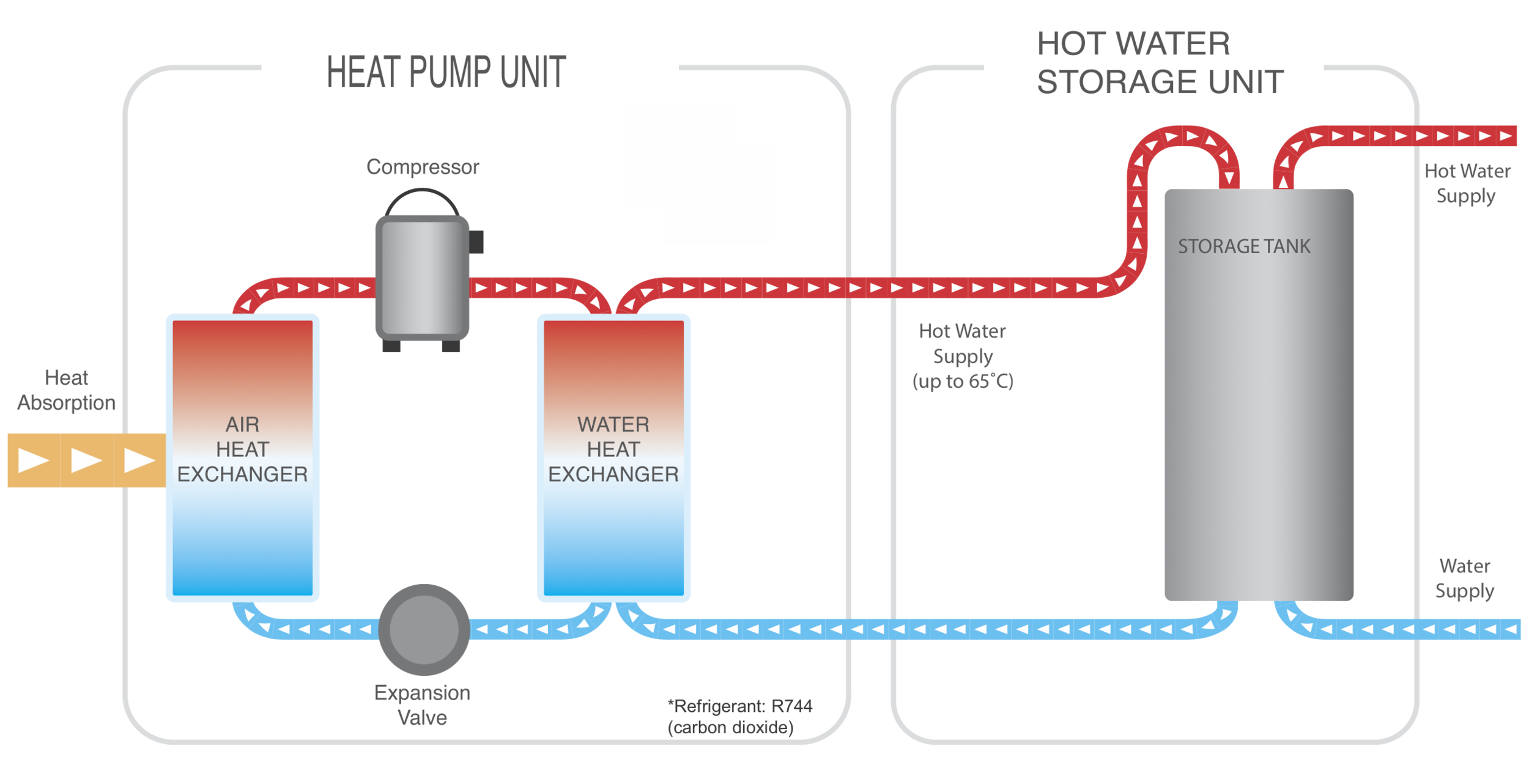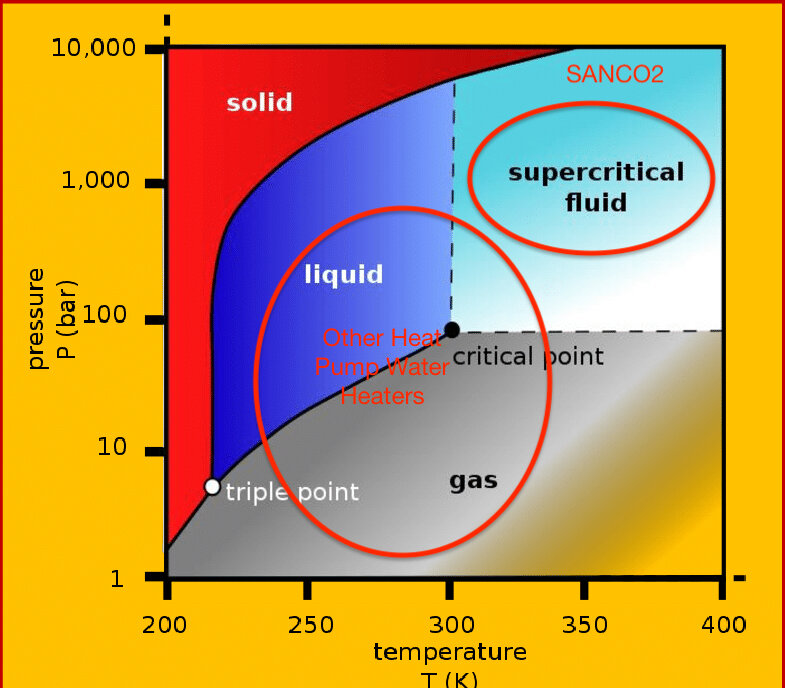SANCO2 101: The Fundamentals of Game Changing Hot Water
/Our past blog posts have highlighted using the SANCO₂ heat pump water heater for combi-system (using SANCO₂ to perform both space and hot water heating) and multi-family applications. This blog post focuses on the basics of the technology that makes SANCO₂ a brilliant choice for energy-efficient hot water heating in most homes.
SANCO₂ Units Use Heat Pump Technology
As the name suggests, SANCO₂ uses heat pump technology to heat the water. While traditional gas and electric hot water heaters heat up water that is inside a tank, using energy to heat water, heat pumps work differently. Heat pumps move heat from one place to another. Because they move heat rather than making it, heat pumps save energy.
If it seems like this heat pump technology shouldn’t work, don’t worry; it already has a proven track record. Heat pumps are the same technology that makes your air conditioner or refrigerator work. As stated earlier, heat pumps work by moving heat from one place to another. While a refrigerator removes heat from an enclosed box and expels that heat to the surrounding air, a heat pump water heater takes the heat from surrounding air and transfers it to water in an enclosed water tank resulting in heated water. So, it’s a process we already know, just working in reverse.
Graphic Credit: SANCO2
Heat Pump Water Heaters Use Refrigerants; SANCO Uses CO₂
In the realm of green building, carbon dioxide (CO₂) is a pretty big buzz word. Carbon dioxide is one of the main gases responsible for the greenhouse effect and is the measure by which we compare other pollutants. If you’re a globally conscious consumer, at first glance It may seem counter-intuitive to use a carbon dioxide refrigerant to reduce global warning, but it isn’t. While other heat pump water heaters use R-134A or similar refrigerants, SANCO₂’s refrigerant is exponentially less impactful. The Global Warming Potential (GWP) is the measure of how destructive a pollutant can be. C02 refrigerant is around 1 GWP versus 1,430 for R-134A. That’s nearly 1,500 times the GWP of CO₂! While using CO₂ as a refrigerant may feel like it’s new here, it’s been used in Japan since the early 2000s. In fact, CO₂ heat pumps have now reached a market share of 98% of all new residential heat pump water heaters in Japan.[1] In addition to being more environmentally friendly, CO₂ has the ability to reach a trans-critical state which allows it to release more energy than other heat pump water heaters.
How SANCO₂ Uses CO₂ to Produce Hot Water
Inside the gen4 SANCO₂ heat pump by ECO₂ Systems is a high pressure scroll compressor and a loop containing CO₂ gas which is connected to a heat exchanger. This special compressor allows the CO₂ to be put in a trans-critical cycle, which produces large amounts of heat. Cold water passes through the heat exchanger, harvesting the energy and storing it in insulated tanks as hot water for household use.
SANCO₂ hot water heater’s advanced technology results in fast, efficient hot water delivery. In fact, SANCO₂ have the highest first hour rating of any comparably sized electric or heat pump water heater. Uniform First Hour Rating (UFHR) is a measure of the volume of water a system can deliver at three gpm/125 degrees in one hour. With a 43-gallon tank, the SANCO₂ system can deliver 69 gallons in its first hour!
SANCO₂ Energy Savings Compared to Traditional Gas and Electric Hot Water Heaters
Supercritical is a bad thing in mothers and life partners, but a good thing when heating hot water. USINg c02 as a refrigerant increases the efficiency (AND THUS, COP) of SANCO2 because CO2 is able to achieve a supercritical state.
Using a SANCO₂ uses much less energy than traditional electric resistance hot water heaters. SANCO₂ systems can achieve as much as 80% operational savings over traditional models since SANCO₂ WHs are so much more efficient. Efficiency is measured by Coefficient of Performance. Coefficient of Performance basically refers to how much energy is produced for each unit of energy used in heating water. SANCO₂ achieves a Coefficient of Performance (COP) of up to 5.5, this handily beats out gas (average COP 0.6) and electric (average COP 0.89). Other heat exchanger water heaters exist, at upwards of 2.5 COP, but these use refrigerants with a much higher GWP, and SANCO₂ systems still outperform these and offer 40%+ operational savings. Depending on hot water use, a return on investment in the two to three-year time frame is possible!
SANCO₂ Can Be Used in Wide Range of Climates
Yet another advantage over similar systems is that SANCO₂ heat pumps will make hot water below -25F temperatures, making them relevant to a wide range of climates in North America. They even pair well with homes using solar panels, as the heat pump will use less than 2,000 watts maximum. Additionally, SANCO₂ systems store hot water at much higher temperatures and mix it with cool water to deliver target faucet temperatures. This allows for much smaller storage tank volumes than other models.
SANCO₂ Tank Storage Options
SANCO₂ stainless steel tanks come in 43- and 83-gallon sizes. SANCO₂ also offer a 119-gallon glass lined tank as well as glass lined tanks in sizes up to 505 gallons for large multifamily buildings. Since the heat pump and tank are separated, this gets rid of the need for any ventilation at the tank location, unlike gas and hybrid hot water heaters. These tanks are specially designed to take advantage of thermal stratification inside. The tank stores cold and hot water simultaneously. This ensures the heat pump has enough cold-water volume to match the hot-water volume and increases efficiency by allowing the pump to heat large amounts of water quickly and store it for use.
SANCO₂ Stands Behind Their Product
If you’re considering purchasing a SANCO₂, you can be assured that a SANCO₂ builds a durable product. And, with a worry free 10-year warranty for the heat pump, 3-year labor, and up to a 15-year tank warranty (for stainless steel tanks), SANCO₂ has the longest and most comprehensive warranty on the water heater market. Plus, they are easy to install; only plumbing connections are required to connect the storage tank and heat pump!
By combining high efficiency and lower impact refrigerant, SANCO₂ hot water systems can claim to be the most environmentally friendly water heater on the market. Pair one of these with other environmentally friendly appliances and efficient building techniques and take your home up a notch. To learn even more about SANCO₂, you can visit Small Planet’s SANCO₂ page, visit our learning center, or schedule a consultation to see how SANCO₂ can meet your needs.
[1] http://www.r744.com/articles/7084/co_sub_2_sub_heat_pumps_bringing_natural_refrigerants_to_japanese_homes











